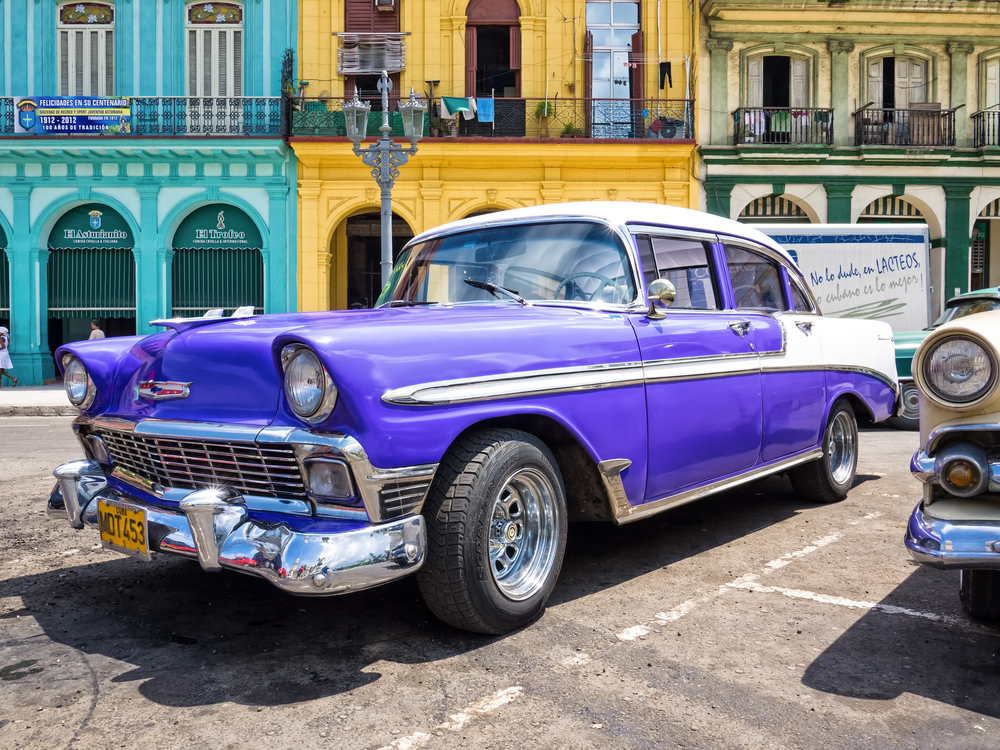
I’m handy. I began early, learned how to use hand tools from my father, a hands-on electrical engineer who designed and built prototype instruments to measure outcomes of physics and biology research projects. I’ve constructed everything from mercury barometers to mine shafts to cherry wood cabinets, from stage sets and circus rings to birch plywood captain’s beds, from community centers to kitchens. I’ve rebuilt an engine for a 1956 Chevy and another for a 1936 Chrysler.
These days I refuse to assemble anything. I was cured of ‘some assembly required’ by the fiendish contraptions offered by Ikea, founded by a Swedish Nazi sympathizer. He was clearly as vicious in his furniture-assembly practices as he was in his political sympathies.
*
But enough about circus rings and Swedish do-it-yourself. I want to take us to another world, where ‘some assembly required’ takes on a very different form. Years ago I made a second trip to Cuba, to attend a Cuban-American writers conference in Havana.
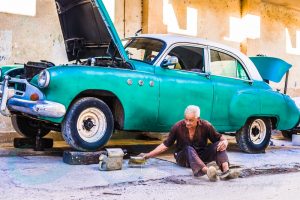 We’ve all seen pics of flashy American cars restored on the streets of Havana. But behind them all, there’s a Cuban mechanic.
We’ve all seen pics of flashy American cars restored on the streets of Havana. But behind them all, there’s a Cuban mechanic.
Cubans make the best mechanics in the world. If you’ve ever had to keep an old car running, you know what I’m talking about. You don’t have the right tools. You work in the street. Your feet stick out in traffic like a couple of ducks.
Because of the blockade and the economic embargo, there have been no new cars or parts coming from the United States for over 50 years. Every piece that breaks has to be manufactured from junk or scabbed onto the machine from other relics. Parts from dead and dying creatures are spirited away to be grafted onto other, more deserving vehicles.
Havana is full of old cars. Parked at the curbs like memories, ancient Fords, Chevys, and an occasional Edsel jockey for space with more recent generations of Russian Volgas and Italian Fiats.
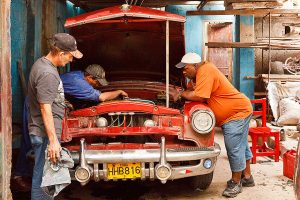 In America, these old cars flash dollars and cents. According to the law of supply and demand, even a derelict version of one of Havana’s American cars would command an obscene price tag from nostalgic collectors. A 1950 Plymouth, its Mayflower hood ornament under full sail, advertises the birth of the Maytag, the Kelvinator, and the single-family home. The tailfins on a ‘58 Dodge Coronet celebrate America’s entry into the space race. A ‘55 Chevy triggers flashbacks to Ozzie and Harriet.
In America, these old cars flash dollars and cents. According to the law of supply and demand, even a derelict version of one of Havana’s American cars would command an obscene price tag from nostalgic collectors. A 1950 Plymouth, its Mayflower hood ornament under full sail, advertises the birth of the Maytag, the Kelvinator, and the single-family home. The tailfins on a ‘58 Dodge Coronet celebrate America’s entry into the space race. A ‘55 Chevy triggers flashbacks to Ozzie and Harriet.
In Cuba, old American cars don’t retire in polished glory to meticulous garages and automotive museums. They’re everywhere. “Mira, compañeros,” I shout to my friends as another American dinosaur roars past. “Look at that Chrysler New Yorker!” The smoke from its passage rises to join the cloud of sulfates hanging under the Vedado district’s graceful trees. I don’t care about the smog. I breathe it in like perfume and laugh with delight. I can recognize every model, every year, the lines of the bodywork surging up from the archives of my adolescent past like a Marilyn Monroe pin-up.
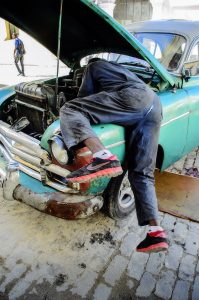 By the simple miracle of their rattling passages through Havana’s streets, Cuba’s cars confirm that Cuba’s revolution is alive, hanging on, making it. Havana’s mechanics are thumbing their nose at the American blockade. They have learned how to pick the bones of their vanquished oppressor.
By the simple miracle of their rattling passages through Havana’s streets, Cuba’s cars confirm that Cuba’s revolution is alive, hanging on, making it. Havana’s mechanics are thumbing their nose at the American blockade. They have learned how to pick the bones of their vanquished oppressor.
But what about the Cubans? How do they feel about their old cars? Are they inspired by their own ingenuity? Do they celebrate tiny victories over worn-out shock absorbers, disintegrating carburetors, and slipping clutches?
Some mechanicos are proud. We drove to uno partida de beisbol at Havana’s Estadio Panamerica in a Plymouth that was 50 years old and looked brand-new in dim light of the Cuban night. The old car rode like a Sherman tank but the tape deck was digital. We listened to Chico O’ Farrell play the saxophone while every pothole in the road transmitted itself through the chassis to the steering wheel and the seats.
“¿Original?”I asked.
“Con seguro,” the driver replied. “Puro.” He laughed and patted the dashboard.
Others were modest about their ingenuity. After the game, we flagged down a young guy in a Studebaker. It was Saturday night and there wasn’t a cab in sight. We asked the driver if he would take us to a restaurant.
“No problema,” he replied and glanced in the rear-view mirror for the cops. As in America, it is against the law for unlicensed Cuban drivers to accept fares. We piled in and bumped down the boulevard. The driver shifted the gears with a lever mounted on the transmission hump. From some deep pool, I pulled the recollection that these old Studebakers all had column shifts.
“¿Original?” I asked and pointed to the gearbox.
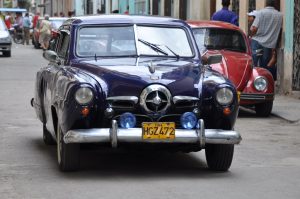 “No, no,” he replied and grinned. “Volga, Rusia, todo. Motor, caja, transmission.” My jaw dropped in amazement. This guy had completely replaced the 50-year-old organs of the Studebaker with a 30-year-old transplant from a Soviet passenger car. It was an impossible task. The cars were different sizes. The engine mounts wouldn’t have fit. Did he have to shorten or lengthen the driveshaft? How did he get the shift lever to surface at the right place beneath his hand?
“No, no,” he replied and grinned. “Volga, Rusia, todo. Motor, caja, transmission.” My jaw dropped in amazement. This guy had completely replaced the 50-year-old organs of the Studebaker with a 30-year-old transplant from a Soviet passenger car. It was an impossible task. The cars were different sizes. The engine mounts wouldn’t have fit. Did he have to shorten or lengthen the driveshaft? How did he get the shift lever to surface at the right place beneath his hand?
He was a fourth-year engineering student and had done all the work himself. Over and over, I congratulated him on his ingenuity while he laughed and shook his head. “Insignificante,” he said. “Es necesario, simplemente.”
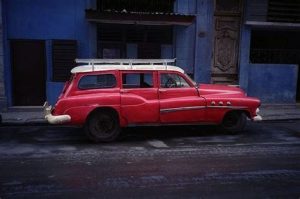 The next day, I spotted a ‘48 Buick Special sitting by the curb of a narrow alley. The Buick’s grill had long since disintegrated. A bundle of one-inch galvanized pipe sprawled through the broken-out rear window, waiting to be delivered somewhere. The once-skirted and chromed wheel wells had been torched into ragged half-circles to allow for larger wheels to be installed on the axles.
The next day, I spotted a ‘48 Buick Special sitting by the curb of a narrow alley. The Buick’s grill had long since disintegrated. A bundle of one-inch galvanized pipe sprawled through the broken-out rear window, waiting to be delivered somewhere. The once-skirted and chromed wheel wells had been torched into ragged half-circles to allow for larger wheels to be installed on the axles.
Three men squatted on the ground in front of the Buick. All three were dressed in ragged t-shirts and cut-offs. All three were slathered with grit and oil. Two of them held the knuckle of a universal joint on a paving stone that had been torn up to form an anvil. The third man beat on the joint with a broken ball-peen hammer. The men grimaced while the universal joint jumped and shifted beneath every blow.
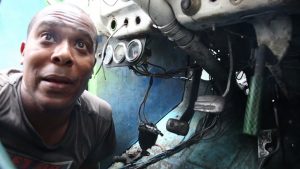 “¿Original?” I asked, and laughed.
“¿Original?” I asked, and laughed.
The hammer stopped in mid-air. Three strained and grease-stained faces looked up at me. There was no acknowledgment, no reply. Instead the three men turned away and resumed their task. There was no solidarity here, no revolution to celebrate. There was nothing to laugh about.
# # #
* “Los Mecánicos” was published with the title “Under Havana’s Hood” in Cuba, a Travelers Tales anthology.
Writer, editor, and educator based in Los Angeles. He's also played a lot of music. Degelman teaches writing at California State University, Los Angeles.
Degelman lives in the hills of Hollywood with his companion on the road of life, four cats, assorted dogs, and a coterie of communard brothers and sisters.



This is a firsthand look from “on the ground” in Cuba, Charles, that I especially appreciate after all the TV shows and movies showing the old American cars. The ingenuity here is amazing, born, as you relate, out of necessity. I don’t think I’ve seen a working Studebaker since I was a kid. Before I read your story I was going to grouse about Gen Z’s lack of interest in fixing or building things, but this afternoon I went for a walk around my neighborhood and saw something astounding. As I rounded a corner and passed a driveway, a young man, late teens or early 20s, scooched himself out from under a Jeep that he was working on. Next to the Jeep was a perfectly restored 1969 Corvette, which I recognized because a high school classmate had one new. Restored (pardon the pun) my faith in Gen Z.
I’m glad you saw behind the tourist glitz, Marian. It’s always difficult to keep an old car running, but with no access to replacement parts, the process becomes a blend of craft, artistry, and desperation. Love your story about the young man with a mechanical bent. I stopped being able to — or wanting to — work on my own cars since the end of carburetors and distributors. Hopefully we’ll all be away from fossil-fuel road romance before the end of our lifetimes!
Wow Charles, I was aware of the phenomenon of rebuilt old American cars still running on the streets in Cuba and the economics driving that need, but thanx for pulling me out of my comfort zone and taking me for the ride!
Wonderful first-hand account of the ingenuity that has been forced on the Cuban fleet of cars (the Pandemic may cause another sort of reckoning with America’s need for new cars).
As a Detroit child of the ’50s, I particularly loved your paragraph that began, “In America, these old cars flash dollars and cents.” As I’ve mentioned, when I was growing up, my father owned a Chrysler dealership. He always had the newest car in the driveway, usually an Imperial with all the bells and whistles, even a record player once. The carpet was so luxurious that I remember napping on the floor of the back. But he often gave it out as a loaner to others when he took their car in for service. My mother drove a Valiant.
I love that you equated the tail fins with the space age (true) and the ’55 Chevy triggering flashbacks to Ozzy and Harriet, a universal family show for all of us. I could even understand your Spanish. A great look into another culture and their inventive ways of dealing with the hand they’ve been dealt.
Thanks, Betsy. Perhaps you’re right about a U.S. version of automotive ingenuity, but I suspect (hope) we’re swinging toward electricity and a culture that will support public transportation. Many changes due from the pandemic.
Wonderful story, Charlie. I am intrigued by your first paragraph, and would love to hear more about the building projects you’ve done over the years. Do you have time for another story this week?
I also love your description of the Cubans and their American cars. In the park across the street from my house, almost every Sunday, car clubs and other car aficionados gather with their lovingly restored ’50s and ’60s cars while everyone oohs and ahs. The car owners are generally Hispanic, but I would say probably Mexican rather than Cuban. Wonder if there’s a connection.
Thanks, Suzy. It would be fun to write a memoir of me and my hands and how I kept my musician’s fingers intact! I’m busy building a book this week, getting my third resistance novel thru cover design, layout, writing acknowledgments, intros, etc. But it’s a great idea for a story long or short. Did you ever read Tracy Kidder’s memoir “House,” set in Western Massachusetts? I was building cabinets nearby on a farm commune full of ex-SDSers nearby.
I’m guessing your nearby park’s auto gathering is based in the low-rider tradition, with some beautified street racers as well.
Having seen these cars and traveled in them in Cuba, I love this story. You captured so much about the ingenuity and skill of a people who have learned to make do with what they have. Perfect pictures. I really enjoyed reading this.
Thanks, Laurie. Ingenuity rules in Cuba. I captured more of that, in the theatre festival we performed in during the special period, after the Soviet Union collapsed. You can read that via the link in this story!
Brilliant fascinating story, Charles. Like others, I well know about Cubans old American car sub-culture — I even have a beautiful carved wooden model of an old Chevy that my daughters gave me fro their trip to Cuba some years ago. But I never stopped to think of the obvious: behind every great (or at least still running) old car in Cuba, there must be a great mechanico.
There are so many captivating passages in this story, I cannot begin to recount them. But that last, non-laughing one really told a whole story in itself. Thank you for sharing this with us Retro folks.
Thank you, John. I’m glad the arc of the story came across. The cars, charming though they are, provide a metaphor for the larger realities of Cuba. I haven’t been there recently, and I hope the protests are gaining ground in most areas, but the reality continues — Cuba remains a damned difficult place to live, and by now, the United States should have been able to embrace its contradictions well enough to lift an embargo that began in another era.
I have a college classmate who is a Cuban refugee and grew up in Miami. On the assumption that he is representative of the mindset of so many Cuban-Americans, I’m afraid that nothing will change by way of US policy for another generation.
Yeah, John, Cuban Americans occupy a special niche in the great embargo battle. Never have so few… And yet I have friends who tell stories about inter-generational clashes between younger generations and the gusanos who are dying out. For several generations now, they’ve been telling their parents and great-grandparents to ‘get over it.’ But the gusano generation doesn’t have the power to keep the embargo going, loud though they may be. There are larger, darker forces at work.
This is is a very interesting and well written piece on cars in Cuba and the deft mechanics found there who keep them moving, Charles. I must admit I didn’t know about this, and I’m glad for the enlightenment. I’ll start looking around the area for a good Cuban mechanic, although the chances of finding one in Lexington, KY, are probably slim!
Ingenuity provides the key to survival in Cuba. Hopefully its gotten better, but there isn’t an aspect of Cuban life that doesn’t require recycling, adapting, fabricating everything from carburetors to printing ink (made from used motor oil). Mexico follows a close second for ingenuity, especially in the area of mechanics — transportation, farming, even mining. You might find a good Mexican mechanic in Lexington. I have a mechanic and a friend (a fellow musician) who runs a remarkably dependable repair garage right down the street from me, but this is L.A. For more ingenuity from both sides, you might want to peruse another Cuba story I tell about bringing a theater company to Cuba during the Special Period that followed the dissolution of the U.S.S.R. In a year’s time, Cuba lost 70 percent of its trade revenue. Here’s the story… https://www.myretrospect.com/stories/periodo-especial/
Thanks for the well-crafted story and the beautiful pictures too. I envy your handiness–it is a true gift, and it sounds like you have put it to good use over the years. May you not have to use it, only choose to. There is quite an old car culture here in BC, with regular show and shines, lots of time and money and love dedicated to the automobile. One of the best things about the old cars is that you CAN tinker with them–everything isn’t run by computer–duct tape and baling wire and other ingenuity can actually work. Looking forward to when the chassis is lovely but the guts are replaced by electric motors. In Cuba, the old cars are maintained at least as much from necessity as love. Same story in medicine; the embargo has forced tinkering with public health priorities, use of local medications, and innovation. They say, “we live like the poor, but we die like the rich” (i.e. lifespan, cancer and heart disease, not infectious disease and malnutrition).
Thanks, Khati. Yes, I can fully appreciate my abilities now that I’ve passed the starving artist chapter. By fully appreciating them, I mean, I don’t need to do any of it, although I reveled in much of the carpentry and cabinet making. I wrote a novel set in mountains of Colorado that was structured around the demolition, rebuilding, sabotage of a community center made of recycled materials. It’s called, aptly enough, A Bowl Full of Nails. Every once in a while I yearn to have a nice, clean, sawdust-scented shop to play in, but not enough to clear out the garage.
I’m with you on automobiles. I stopped doing any mechanical work when carburetors and distributors disappeared. If the parts don’t move, I can’t fix it.
I’ve had some experience with the Cuban medical system. It’s a marvel of a system where public well-being replaces profiteering as the top priority. I visited a hospital that Cuba built to care for Ukranian children who had been irradiated at Chernobyl. All the kids were gone by then, but it stood as a tribute to Cuban healthcare and compassion. They also developed a plant-based anti-cholesterol statin because their diets are so lousy; not a vegetable in sight.
Fascinating! Sad that there is insufficient political will or courage here to normalize relations with Cuba.
Thanks, Dave. As time goes by, the blockade become more mystifying. All the old landowner ricos have died with Fidel, their arch enemy. I noticed that the NYTimes or WaPo casually listed Cuba as a pariah nation alongside Putin’s Russia, which blew my mind. What’s the beef?